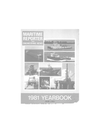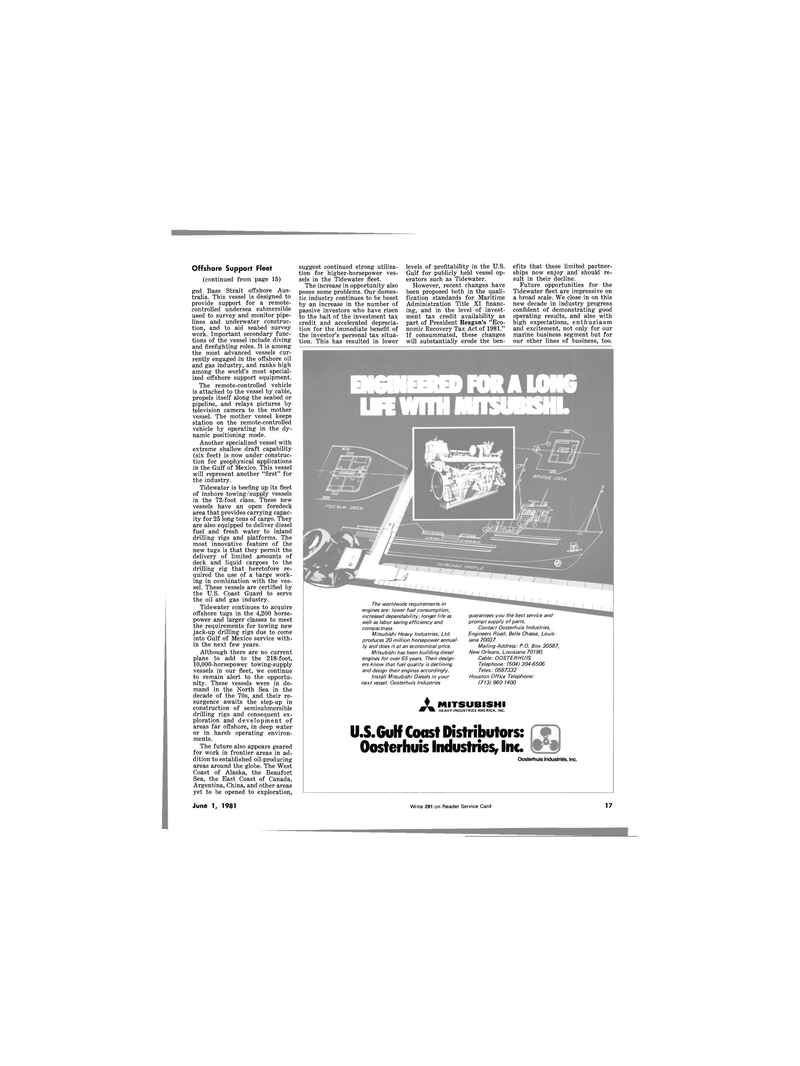
Page 3rd Cover: of Maritime Reporter Magazine (June 1981)
Read this page in Pdf, Flash or Html5 edition of June 1981 Maritime Reporter Magazine
Offshore Support Fleet (continued from page 15) ged Bass Strait offshore Aus- tralia. This vessel is designed to provide support for a remote- controlled undersea submersible used to survey and monitor pipe- lines and underwater construc- tion, and to aid seabed survey work. Important secondary func- tions of the vessel include diving and fireflghting roles. It is among the most advanced vessels cur- rently engaged in the offshore oil and gas industry, and ranks high among the world's most special- ized offshore support equipment.
The remote-controlled vehicle is attached to the vessel by cable, propels itself along the seabed or pipeline, and relays pictures by television camera to the mother vessel. The mother vessel keeps station on the remote-controlled vehicle by operating in the dy- namic positioning mode.
Another specialized vessel with extreme shallow draft capability (six feet) is now under construc- tion for geophysical applications in the Gulf of Mexico. This vessel will represent another "first" for the industry.
Tidewater is beefing up its fleet of inshore towing/supply vessels in the 72-foot class. These new vessels have an open foredeck area that provides carrying capac- ity for 25 long tons of cargo. They are also equipped to deliver diesel fuel and fresh water to inland drilling rigs and platforms. The most innovative feature of the new tugs is that they permit the delivery of limited amounts of deck and liquid cargoes to the drilling rig that heretofore re- quired the use of a barge work- ing in combination with the ves- sel. These vessels are certified by the U.S. Coast Guard to serve the oil and gas industry.
Tidewater continues to acquire offshore tugs in the 4,200 horse- power and larger classes to meet the requirements for towing new jack-up drilling rigs due to come into Gulf of Mexico service with- in the next few years.
Although there are no current plans to add to the 218-foot, 10,000-horsepower towing-supply vessels in our fleet, we continue to remain alert to the opportu- nity. These vessels were in de- mand in the North Sea in the decade of the 70s, and their re- surgence awaits the step-up in construction of semisubmersible drilling rigs and consequent ex- ploration and development of areas far offshore, in deep water or in harsh operating environ- ments.
The future also appears geared for work in frontier areas in ad- dition to established oil-producing areas around the globe. The West
Coast of Alaska, the Beaufort
Sea, the East Coast of Canada,
Argentina, China, and other areas yet to be opened to exploration, suggest continued strong utiliza- tion for higher-horsepower ves- sels in the Tidewater fleet.
The increase in opportunity also poses some problems. Our domes- tic industry continues to be beset by an increase in the number of passive investors who have risen to the bait of the investment tax credit and accelerated deprecia- tion for the immediate benefit of the investor's personal tax situa- tion. This has resulted in lower levels of profitability in the U.S.
Gulf for publicly held vessel op- erators such as Tidewater.
However, recent changes have been proposed both in the quali- fication standards for Maritime
Administration Title XI financ- ing, and in the level of invest- ment tax credit availability as part of President Reagan's "Eco- nomic Recovery Tax Act of 1981."
If consummated, these changes will substantially erode the ben- efits that these limited partner- ships now enjoy and should re- sult in their decline.
Future opportunities for the
Tidewater fleet are impressive on a broad scale. We close in on this new decade in industry progress confident of demonstrating good operating results, and also with high expectations, enthusiasm and excitement, not only for our marine business segment but for our other lines of business, too.
ENGINEERED FOR A LONG
LIFE WITH MITSUBISHI.
BRIDGE
The worldwide requirements in engines are: lower fuel consumption, increased dependability, longer life as well as labor saving efficiency and compactness.
Mitsubishi Heavy Industries, Ltd. produces 20 million horsepower annual- ly and does it at an economical price.
Mitsubishi has been building diesel engines for over 65 years. Their design- ers know that fuel quality is declining and design their engines accordingly.
Install Mitsubishi Diesels in your next vessel. Oosterhuis Industries
A guarantees you the best service and prompt supply of parts.
Contact Oosterhuis Industries,
Engineers Road, Belle Chasse, Louis- iana 70037.
Mailing Address: P.O. Box 30587,
New Orleans, Louisiana 70190.
Cable: OOSTERHUIS
Telephone: (504) 394-6506
Telex: 0587332
Houston Office Telephone: (713) 960-1400
MITSUBISHI
HEAVY INDUSTRIES AMERICA, INC.
U.S.GuK Coast Distributors:
Oosterhuis Industries, Inc.
Oosterhuis Industries, Inc.
June 1, 1981 Write 291 on Reader Service Card 17

 16
16

 4th Cover
4th Cover
